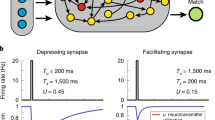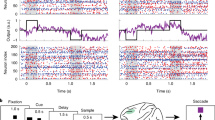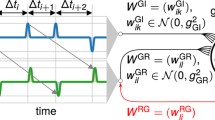Abstract
Experimental evidence suggests that the maintenance of an item in working memory is achieved through persistent activity in selective neural assemblies of the cortex. To understand the mechanisms underlying this phenomenon, it is essential to investigate how persistent activity is affected by external inputs or neuromodulation. We have addressed these questions using a recurrent network model of object working memory. Recurrence is dominated by inhibition, although persistent activity is generated through recurrent excitation in small subsets of excitatory neurons.
Our main findings are as follows. (1) Because of the strong feedback inhibition, persistent activity shows an inverted U shape as a function of increased external drive to the network. (2) A transient external excitation can switch off a network from a selective persistent state to its spontaneous state. (3) The maintenance of the sample stimulus in working memory is not affected by intervening stimuli (distractors) during the delay period, provided the stimulation intensity is not large. On the other hand, if stimulation intensity is large enough, distractors disrupt sample-related persistent activity, and the network is able to maintain a memory only of the last shown stimulus. (4) A concerted modulation of GABA A and NMDA conductances leads to a decrease of spontaneous activity but an increase of persistent activity; the enhanced signal-to-noise ratio is shown to increase the resistance of the network to distractors. (5) Two mechanisms are identified that produce an inverted U shaped dependence of persistent activity on modulation. The present study therefore points to several mechanisms that enhance the signal-to-noise ratio in working memory states. These mechanisms could be implemented in the prefrontal cortex by dopaminergic projections from the midbrain.
Similar content being viewed by others
References
Abeles M (1991) Corticonics. Cambridge University Press, New York.
Amit DJ (1995) The Hebbian paradigm reintegrated: Local reverberations as internal representations. Behav. Brain Sci. 18:617.
Amit DJ, Brunel N (1997) Model of global spontaneous activity and local structured activity during delay periods in the cerebral cortex. Cerebral Cortex 7:237-252.
Arnsten AFT (1998) Catecholamine modulation of prefrontal cortical cognitive function. Trends in Cognitive Sciences 2:436-447.
Braitenberg V, Schütz A (1991) Anatomy of the Cortex. Springer-Verlag: Berlin.
Brozoski TJ, Brown RM, Rosvold HE, Goldman PS (1979) Cognitive deficit caused by regional depletion of dopamine in prefrontal cortex of rhesus monkey. Science 205:929-932.
Brunel N (2000) Persistent activity and the single cell f-I curve in a cortical network model. Network 11:261-280.
Brunel N, Carusi F, Fusi S (1998) Slow stochastic Hebbian learning of classes in recurrent neural networks. Network 9:123-152.
Brunel N, Hakim V (1999) Fast global oscillations in networks of integrate-and-fire neurons with low firing rates. Neural Comput. 11:1621-1671.
Brunel N, Sergi S (1998) Firing frequency of integrate-and-fire neurons with finite synaptic time constants. J. Theor. Biol: 195:87-95.
Burns BD, Webb AC (1976) The spontaneous activity of neurons in the cat's cerebral cortex. Proc. R. Soc. Lond. B 194:211-223.
Cai JX, Anrsten AFT (1997) Dose-dependent effects of the dopamine D1 receptor agonists A77636 or SKF81297 on spatial working memory in aged monkeys. J. Pharmacol. Exp. Ther. 282:1-7.
Camperi M, Wang XJ (1998) A model of visuospatial short-term memory in prefrontal cortex: Recurrent network and cellular bistability. J. Comput. Neurosci. 5:383-405.
Cepeda C, Levine MS (1998) Dopamine and N-methyl-D-aspartate receptor interactions in the neostriatum. Dev. Neurosci. 20:1-18.
Cepeda C, Radisavljevic Z, Peacock W, Levine MS, Buchwald NA (1992) Differential modulation by dopamine of responses evoked by excitatory amino acids in human cortex. Synapse 11:330-341.
Compte A, Brunel N, Goldman-Rakic PS, Wang XJ (2000) Synaptic mechanisms and network dynamics underlying spatial working memory in a cortical network model. Cerebral Cortex 10:910-923.
Condé F, Jacobowitz DM, Baimbridge KG, Lewis DA (1994) Local circuit neurons immunoreactive for calretinin, calbindin D-28k or parvalbumin in monkey prefrontal cortex: Distribution and morphology. J. Comp. Neurol. 341:95-116.
Daniel DG, Weinberger DR, Jones DW, Zigun JR, Coppola R, Handel S, Bigelow LB, Goldberg TE, Berman KF, Kleinman JE (1991) The effect of amphetamine on regional cerebral blood flow during cognitive activation in schizophrenia. J. Neurosci. 11: 1907-1917.
Destexhe A, Mainen ZF, Sejnowski TJ (1998) Kinetic models of synaptic transmission. In: Koch C, Segev I, eds. Methods in Neuronal Modeling (2nd ed.). MIT Press, Cambridge, MA. pp. 1-25.
Douglas RJ, Koch C, Mahowald M, Martin KM, Suarez HH (1995) Recurrent excitation in neocortical circuits. Science 269:981-985.
Durstewitz D, Kelc M, Güntürkun O (1999) A neurocomputational theory of the dopaminergic modulation of working memory functions. J. Neurosci. 19:2807-2822.
Durstewitz D, Seamans JK, Sejnowski TJ (2000) Dopamine-mediated stabilization of delay-period activity in a network model of prefrontal cortex. J. Neurophysiol. 83:1733-1750.
Egan MF, Weinberger DR (1997) Neurobiology of schizophrenia. Curr. Opin. Neurobiol. 7:701-707.
Funahashi S, Bruce CJ, Goldman-Rakic PS (1989) Mnemonic coding of visual space in the monkey's dorsolateral prefrontal cortex. J. Neurophysiol. 61:331-349.
Fuster JM, Alexander G (1971) Neuron activity related to short-term memory. Science 173:652-654.
Fuster JM, Jervey JP (1981) Inferotemporal neurons distinguish and retain behaviourally relevant features of visual stimuli. Science 212:952-955.
Gabbott PLA, Bacon SJ (1996) Local circuit neurons in the medial prefrontal cortex (areas 24a,b,c, 25 and 32) in the monkey. J. Comp. Neurol. 364:567-636.
Gellman RL, Aghajanian GK (1993) Pyramidal cells in piriform cortex receive a convergence of inputs from monoamine activated GABAergic interneurons. Brain Res. 600:63-73.
Goldman-Rakic PS (1987) Circuitry of primate prefrontal cortex and regulation of behavior by representational memory. In: Handbook of Physiology: The Nervous System V. American Physiological Society, Bethesda, MD. Chapter 9, pp. 373-417.
Goldman-Rakic PS (1994) Working memory dysfunction in schizophrenia. J. Neuropsych. and Clin. Neurosci. 6:348-357.
Goldman-Rakic PS (1995) Cellular basis of working memory. Neuron 14:477-485.
Hansel D, Mato G, Meunier C, Neltner L (1998) On numerical simulations of integrate-and-fire neural networks. Neural Comput. 10:467-483.
Hebb DO (1949) Organization of Behavior. Wiley, New York.
Hestrin S, Sah P, Nicoll R (1990) Mechanisms generating the time course of dual component excitatory synaptic currents recorded in hippocampal slices. Neuron 5:247-253.
Jahr CE, Stevens CF (1990) Voltage dependence of NMDA-activated macroscopic conductances predicted by single-channel kinetics. J. Neurosci. 10:3178-3182.
Kawaguchi Y (1997) Selective cholinergic modulation of cortical GABAergic cell subtypes. J. Neurophysiol. 78:1743-1747.
Koch KW, Fuster JM (1989) Unit activity in monkey parietal cortex related to haptic perception and temporary memory. Exp. Brain Res. 76:292-306.
Kubota K, Niki H (1971) Prefrontal cortical unit activity and delayed alternation performance in monkeys. J. Neurophysiol. 34:337-347.
Law-Tho D, Hirsch JC, Crepel F (1994) Dopamine modulation of synaptic transmission in rat prefrontal cortex: An in vitro electrophysiological study. Neurosci. Res. 21:151-160.
Lorente de Nó R (1933) Vestibulo-ocular reflex arc. Arch. Neurol. Psych. 30:245-291.
Mascaro M, Amit DJ (1999) Effective neural response function for collective population states. Network 10:351-373.
McCormick D, Connors B, Lighthall J, Prince D (1985) Comparative electrophysiology of pyramidal and sparsely spiny stellate neurons in the neocortex. J. Neurophysiol. 54:782-806.
Miller EK, Erickson CA, Desimone R (1996) Neural mechanisms of visual working memory in prefrontal cortex of the macaque. J. Neurosci. 16:5154-5167.
Miyashita Y (1988) Neuronal correlate of visual associative long-term memory in the primate temporal cortex. Nature 335:817-820.
Miyashita Y, Chang HS (1988) Neuronal correlate of pictorial short-term memory in the primate temporal cortex. Nature 331:68-70.
Muly III EC, Szigeti K, Goldman-Rakic PS (1998) D1 receptor in interneurons of macaque prefrontal cortex: Distribution and subcellular localization. J. Neurosci. 18:10553-10565.
Murray JD (1993) Mathematical Biology. Springer-Verlag, Berlin.
Nakamura K, Kubota K (1995) Mnemonic firing of neurons in the monkey temporal pole during a visual recognition memory task. J. Neurophysiol. 74:162-178.
Nicola SM, Surmeier DJ, Malenka RC (2000) Dopaminergic modulation of neuronal excitability in the striatum and nucleus accumbens. Ann. Rev. Neurosci. 23:185-215.
Okubo Y, Suhara T, Suzuki K, Kobayashi K, Inoue O, Terasaki O, Someya Y, Sassa T, Sudo Y, Matsushima E, Iyo M, Tateno Y, Toru M (1997) Decreased prefrontal dopamine D1 receptors in schizophrenia revealed by PET. Nature 385:634-636.
Penit-Soria J, Audinat E, Crepel F (1987) Excitation of rat prefrontal cortical neurons by dopamine: An in vitro electrophysiological study. Brain Res. 425:263-274.
Pinto DJ, Brumberg JC, Simons DJ, Ermentrout GB (1996) A quantitative population model of whisker barrels: Re-examining the Wilson-Cowan equations. J. Comput. Neurosci. 3:247-264.
Press WH, Teukolsky SA, Vetterling WT, Flannery BP (1992) Numerical Recipes in C. Cambridge University Press, Cambridge.
Rao SG, Williams GV, Goldman-Rakic PS (1999) Isodirectional tuning of adjacent interneurons and pyramidal cells during working memory: Evidence for microcolumnar organization in PFC. J. Neurophysiol. 81:1903-1916.
Salin PA, Prince DA (1996) Spontaneous GABAA receptor mediated inhibitory currents in adult rat somatosensory cortex. J. Neurophysiol. 75:1573-1588.
Sawaguchi T, Goldman-Rakic PS (1991) D1 dopamine receptors in prefrontal cortex: Involvement in working memory. Science 251:947-950.
Sawaguchi T, Matsumara M, Kubota K (1990) Catecholaminergic effects on neuronal activity related to a delayed response task in monkey prefrontal cortex. J. Neurophysiol. 63:1385-1400.
Servan-Schreiber D, Printz H, Cohen JD (1990) A network model of catecholamine effects: gain, signal-to-noise ratio, and behavior. Science 249:892-895.
Shadlen MN, Newsome WT (1994) Noise, neural codes and cortical organization. Current Opinion in Neurobiol. 4:569-579.
Somers DC, Nelson SB, Sur M (1995) An emergent model of orientation selectivity in cat visual cortical simple cells. J. Neurosci. 15:5448-5465.
Spruston N, Jonas P, Sakmann B (1995) Dendritic glutamate receptor channel in rat hippocampal CA3 and CA1 pyramidal neurons. J. Physiol. 482:325-352.
Troyer TW, Krukowski AE, Priebe NJ, Miller KD (1998) Contrast-invariance orientation tuning in cat visual cortex: Thalamocortical input tuning and correlation-based intracortical connectivity. J. Neurosci. 18:5908-5927.
Tsodyks MV, Sejnowski T (1995) Rapid state switching in balanced cortical network models. Network 6:111-124.
Tuckwell HC (1988) Introduction to Theoretical Neurobiology. Cambridge University Press, Cambridge.
Umemiya M, Raymond LA (1997) Dopaminergic modulation of excitatory postsynaptic currents in rat neostriatal neurons. J. Neurophysiol. 78:1248-1255.
van Vreeswijk C, Sompolinsky H (1996) Chaos in neuronal networks with balanced excitatory and inhibitory activity. Science 274:1724-1726.
Wang XJ (1999) Synaptic basis of cortical persistent activity: The importance of NMDA receptors to working memory. J. Neurosci. 19:9587-9603.
Williams GV, Goldman-Rakic PS (1995) Modulation of memory fields by dopamine D1 receptors in prefrontal cortex. Nature 376:572-575.
Wilson FAW, Scalaidhe SPO, Goldman-Rakic PS (1993) Dissociation of object and spatial processing domains in primate prefrontal cortex. Science 260:1955-1958.
Wilson FAW, Scalaidhe SPO, Goldman-Rakic PS (1994) Functional synergism between putative γ-aminobutyrate-containing neurons and pyramidal neurons in prefrontal cortex. Proc. Natl. Acad. Sci. USA 91:4009-4013.
Wilson HR, Cowan JD (1973) A mathematical theory of the functional dynamics of cortical and thalamic nervous tissue. Kybernetik 13:55-80.
Xiang Z, Huguenard JR, Prince DA (1998) GABAA receptor mediated currents in interneurons and pyramidal cells of rat visual cortex. J. Physiol. 506:715-730.
Yakovlev V, Fusi S, Berman E, Zohary E (1998) Inter-trial neuronal activity in inferior temporal cortex: A putative vehicle to generate long-term visual associations. Nature Neurosci. 1:310-317.
Yang CR, Seamans JK, Gorelova N (1996) Electrophysiological and morphological properties of layer V-VI principal pyramidal cells in rat prefrontal cortex in vitro. J. Neurosci. 16:1904-1921.
Zahrt J, Taylor JR, Mathew RG, Arnsten AFT (1997) Supranormal stimulation of D1 dopamine receptors in the rodent prefrontal cortex impairs spatial working memory performance. J. Neurosci. 17:8528-8535.
Zheng P, Zhang XX, Bunney BS, Zhi WX (1999) Opposite modulation of cortical N-methyl-D-aspartate receptor-mediated responses by low and high concentrations of dopamine. Neuroscience 91:527-535.
Zhou FM, Hablitz JJ (1999) Dopamine modulation of membrane and synaptic properties of interneurons in rat cerebral cortex. J. Neurophysiol. 81:967-976.
Author information
Authors and Affiliations
Additional information
An erratum to this article is available at http://dx.doi.org/10.1007/s10827-014-0506-8.
Rights and permissions
About this article
Cite this article
Brunel, N., Wang, XJ. Effects of Neuromodulation in a Cortical Network Model of Object Working Memory Dominated by Recurrent Inhibition. J Comput Neurosci 11, 63–85 (2001). https://doi.org/10.1023/A:1011204814320
Issue Date:
DOI: https://doi.org/10.1023/A:1011204814320




